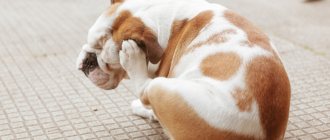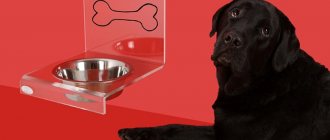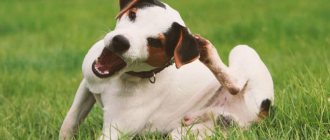4.5 / 5 ( 4 voices)
With the arrival of a puppy in the house, the owners begin a difficult period of life. While the dog is still very young and does not understand the rules of existence in a new family, it is very important to start raising him now. It is the owner who must explain to the new member of the small community what is good and what is bad. And of course, teach the puppy to go to the toilet only in designated areas.
How to stop a puppy from littering the house
Little puppies learn and experience the world like children, and the owner’s task is to teach the pet good manners from the first day it arrives in the house. Puppies are in quarantine for the first 3.5 - 4 months of life due to mandatory immunization against viral infections. Accordingly, all this time they are in the apartment and are forced to crap in the house. During isolation, the puppy develops a strong habit of going to the toilet in its den.
There are several secrets that will help stop your puppy from shitting all over the house:
- It is necessary to choose a separate room for the baby’s toilet - it’s good if it is a balcony or a storage room.
- Cover the entire floor surface in the designated room with paper or a diaper.
- Every time after sleeping and eating, take the puppy for natural needs to the space allocated for the toilet.
- Do not let the pet out of this room until the pet has done its business.
- After emptying the intestines and bladder, praise your pet vigorously so that he understands that the owner approves of his actions.
- During the day, carefully monitor the baby, and at the first signs of going to the toilet (sniffing, circling in one place), immediately pick up the dog and carry it to the room for defecation. You cannot grab a puppy when he has already started peeing; until he is 4 months old, he does not fully control this process and cannot stop it. There will be only one result - a frightened pet and a path of urine throughout the apartment.
- Gradually, your four-legged friend will choose one place in the designated room to defecate, then all other diapers and newspapers can be removed.
But you should not leave your dog alone in a confined space for a long time, especially without light, as this can lead to fear of loneliness or claustrophobia.
Puppies under 4 months of age practically cannot tolerate it if access to the diaper room is limited (the door is closed), you must be prepared for a puddle to appear anywhere . Moreover, during this period, the baby may simply not reach the diaper if it is far away. You can’t scold a dog for this, this is a physiological feature of the body, it’s not the pet’s fault.
If there was a “problem” and the dog went in the wrong place, although the owner tried his best and did everything correctly - in no case should you shout at the baby, physically punish or poke your nose into a pile (puddle). This can lead to terrible stress and fear for the owner; as a result, the puppy will crap, but hide it under carpets, pillows, bedspreads, or even eat the object of the owner’s anger. Further, the owner’s fear will negatively affect the building of relationships and subsequent education.
Basic rules for teaching a puppy to pee on the street
Before you begin to accustom your puppy to walking, you need to remember one important condition - a puppy, starting from 5 months, can tolerate going to the toilet for no more hours than he is months old. If your pet is left at home alone for a longer period of time, he should have access to a diaper, otherwise there will be unpleasant surprises on the floor.
What you need to do to teach your puppy to go to the toilet outside:
- Walk after eating and sleeping.
- Show your approval by defecating in the street.
- Take water for walks and actively water your pet.
- Organize active games (physical exercise speeds up metabolism).
- Praise for sniffing marks (working with the nose triggers the mark reflex).
- Do not run home immediately after defecation.
- The duration of the walk should correspond to the dog's activity.
- For unsure puppies, taking the toilet out of the house is a suitable method.
It often happens that a dog walks along the street for a long time and persistently, but runs home to the toilet, even during long walks . This may be due to the baby's lack of self-confidence. During quarantine, he gets used to certain smells; when he goes outside, the dog is bombarded with a huge amount of scent information. There are several ways out of this situation:
- Walk down the street until the puppy can't stand it anymore.
- Take the diaper out into the yard and walk around it.
- To add self-confidence to your dog while he is in quarantine, carry the baby outside in your arms.
When dealing with a timid dog, it is especially important to show what he is doing right and to minimize negativity in communication. When defecating in the wrong place, ignore it; when defecating on the street, praise it very actively and treat it with treats.
The puppy doesn't pee outside. What to do?
Share:
Some breeds of puppies become potty trained at 4 months, most at 7-8 months, and there are breeds that are notorious for being late and difficult to potty train. We'll talk more about this later. Even if your puppy’s age still cannot tolerate being at home and doing all the “business” outside, this does not mean that he should pee and poop only at home - this way he will never learn to be clean.
There are a few tricks to help your puppy make his first puddle outside.
1) Notice what time the puppy wakes up. Prepare everything in advance - shoes, a raincoat, a hat... Everything - so that you can throw on your outerwear right in your pajamas and take your baby outside. Set an alarm. You get up - a sleepy puppy in the arms of the household, quickly throw on outerwear and carry the pet out onto the lawn in your arms. Walk for 5-10 minutes. Did not work out? It's too early to get upset.
2) Before feeding your puppy, put a collar and leash on him. Place the bowl. As soon as he has eaten, immediately pick him up and take him out onto the lawn. There you wait again for 5-10 minutes. If it didn’t work out this time, your puppy is simply heroically resilient. He endured and endured and brought everything home. Rejoice! His body allows him to control his urges, which means that as soon as he masters cleanliness, he will just as stubbornly “convey” everything to the street.
3) Take care of yourself. Perhaps you throw up your hands in grief when the puppy pees on your favorite carpet once again and you can’t even hold back the reproach: “Why didn’t you do anything on the street!” And then you walk on the street and constantly look at the puppy, thinking: “Well, when?!” The puppy reads the threat in your persistent gaze and, remembering your dissatisfaction at home, is afraid to make a puddle in front of you, waits until you at least turn away... Try to show less emotion when there are puddles at home, and on the street praise the puppy if he sniffs other people’s marks - urine or feces, abandoned by other dogs.
4) Try walking until you're blue in the face. Run with a puppy. Feed him outside, water him... If 3 hours have passed and the puppy still hasn’t peed, move on to the next point...
5) Urine and feces are marks, what dogs use to mark territory. Imagine that you take a flag and go to wave it on the street of a foreign city in an unfamiliar country. The puppy is afraid to leave his scent in the yard, where many other unfamiliar dogs have already left “flags”. Try wiping up a puddle at home with a rag, and then take this rag with you outside. Walk around it and let your puppy sniff it from time to time. And when he sniffs, praise him. The puppy will see that his scent outside is good. Usually, even if not on this, then on the next walk, he will definitely pee on the street.
And then your joy will know no bounds! And passers-by - those who themselves had a dog - will congratulate you or simply smile knowingly. Good luck!
You can find answers to other questions that may arise in the section: “Puppy Guide”
Why did an adult dog start shitting at home?
It is very difficult to give a definite answer to the question - why does an adult dog shit at home . There are probably as many reasons for this phenomenon as there are pets peeing on the carpet. And before solving the problem, it is necessary to understand what its background is.
The main types of problems are physiological or psychological. Each variant has several dozen subspecies. The main versions are presented below, but if nothing helps, you need to contact a zoopsychologist who will help you understand the specific problem.
Physiological ailments
Health problems are often the result of unpleasant surprises at home. In certain situations, the dog simply cannot wait to go for a walk.
The main physiological reasons that lead to incontinence in dogs:
- Internal organ injuries.
- Inflammation of the bladder (cystitis).
- Kidney diseases.
- Problems with the gastrointestinal tract.
- Side effects of medications.
- Overdose of veterinary drugs.
- Hypothermia.
- Viral infections.
- Age.
You can get rid of bowel movements in the house by carefully analyzing the situation. If there is even the slightest suspicion of physiology, it is necessary to urgently contact a veterinary clinic. Carry out all the necessary procedures to identify the factor that led to bowel movements in the apartment. After eliminating the root cause, the effect will disappear on its own.
Psychological abnormalities
Anything related to psychological characteristics is much more difficult to correct. You need to very carefully delve into the delicate soul of a dog.
The main psychological factors why a dog craps at home:
- Fear, phobias.
- Substrate habit.
- Diffidence.
- Too much time without walking.
- Demand for attention.
- Change of usual environment (can be attributed to stress).
- Experienced stress.
- An uncorrected habit of walking indoors since puppyhood.
All problems can be dealt with only by finding out the real reason for the manifestation of destructive behavior. The main obstacle in this situation is that it is impossible to know exactly how the pet behaves in the absence of its owners, and this is very important. In the age of high technology, nothing is impossible anymore - you can leave the camera and watch what happens when the dog is left alone.
How to toilet train a dog
To prevent surprises from appearing in the form of numerous piles and puddles throughout the apartment, it is necessary to constantly work on this issue. You can train your dog to toilet yourself only if this phenomenon is not associated with stress and phobias. In case of psychological abnormalities, a zoopsychologist must work with the animal.
If your pet shows symptoms of phobias and fears, you should not use sedatives and cages, this will only worsen the problem.
Learning sequence and problem solving
After eliminating physiological causes, that is, if the owner knows for sure that the dog is completely healthy, you can begin to solve the problem of defecation in the house.
- Fears, phobias, stress. A number of these problems can only be resolved by an animal psychologist; one must proceed from the individuality of the situation.
- Substrate habit . The solution is easy - the canvas on which the dog is used to doing his business is taken outside.
- Too much time without walking . You must understand that a dog is a living creature and cannot tolerate more than the capacity of its bladder. Regulated by more frequent walking.
- Diffidence . The most common problem in bitches. Males with the onset of puberty, thanks to the release of a huge amount of testosterone into the blood, become more self-confident - they begin to mark their territory, and as a result, they get used to going to the toilet on the street. In females, in the absence of self-confidence, it is necessary to work on “self-esteem”.
- Demand for attention . Dogs that are strongly focused on the owner, but deprived of care (as a rule, young and active individuals) can attract attention to their person in this way. The dog knows that he will do something nasty, the owner will come and scold him, negativity is better than indifference. The situation can be corrected by a correctly built relationship between man and dog in a pack.
- The habit of going to the toilet at home since puppyhood. If the baby has just started to be taken outside, he may still crap in the house simply out of habit. You can get rid of this quickly - you need to completely eliminate the possibility of defecation in the apartment (take the dog and leave the house for the whole day, the baby will have no choice).
Secrets of re-education
The main sacrament of behavior correction is positivity, that is, not punishing the dog for wrongdoing, but praising it for correct actions. Thus, the dog learns to monitor the owner’s reaction, and not avoid communication. Positive reinforcements increase your pet's self-esteem and help you become more confident.
Prohibited Methods
- If a dog shits at home, there is absolutely no point in punishing it unless it is caught red-handed. You can understand the owner - his nerves are not made of steel. But in fact, punishment is not an effective method in correcting destructive behavior.
- Moreover, negative manifestations on the part of the owner entail distrust of the dog. Then there are problems with training and building relationships.
Allowed Methods
It is allowed to use negative reinforcement instead of punishment. Only it should not be very cruel, so as not to traumatize the animal’s psyche. At the moment of defecation (not after!) in the wrong place, you can clap your hands loudly or throw a bunch of keys near the dog. When the pet interrupts the act of defecation out of fright, she must be praised. As a rule, several such repetitions are enough for the dog to understand that the owner is not pleased with surprises on the carpet.
This method will not work with very young puppies; they cannot interrupt the action they have started.
Chemicals
Modern veterinary pharmacies offer a lot of sprays for toilet training dogs. But, they only work if the pet is accustomed to the substrate. They do not fight other physiological and mental disorders.
But they perfectly help get rid of unpleasant odor after bowel movements and bladder.
Folk remedies
There are several folk methods on how to stop a dog from shitting in its favorite place. You can make an essence with the addition of:
- Citrus juice.
- Vinegar.
- Mint.
- Wormwood.
- Eucalyptus.
- Cinnamon.
- Any other ingredient with a strong odor.
A dog's nose is very sensitive; a strong, pronounced smell can scare him away from his favorite place to defecate.
How to teach a dog to be patient
At first, the mother helps the puppies with toilet chores, and they don’t have to worry about anything. Older babies who cannot yet be taken outside are taught to relieve themselves indoors on a diaper or in a special tray. Subsequently, after the first vaccinations have been given and the quarantine has been completed, you can walk the dog outside. However, you should not expect that from the very first days she will stop leaving puddles and piles in the apartment. June 21, 2013
Author: Kirsanova Aglaya
Don’t delay vaccinations: the sooner you take your dog outside , the faster it will get used to relieving itself there. At first, the puppy is taken for a walk after every meal, after sleep, and after active games. Gradually, the number of walks can be reduced, because the older the puppy, the longer he can endure. Be sure to praise him every time he does something outside, you can even treat him with a treat. If you catch your dog relieving himself indoors, scold him. When time has passed since the deed, there is no point in scolding the puppy; he still won’t understand why you are doing it.
At about the age of six months, dogs finally understand what their owners require of them and learn to endure from walk to walk, provided that you take them outside three times a day for at least forty minutes. The more you walk your dog, the better. For some pets, two walks a day are enough. If you don’t have the opportunity to walk more often, then try to spend a couple of hours outside. Dogs need time to calmly mark their territory and find a convenient place for all their business.
In the case when a dog knows how to tolerate , but for some reason does not do this, but continues to leave puddles on the carpet, you can try several ways to fight. First, take the animal to the vet, it may just be unhealthy. If everything is ok, show her your leadership. The next time you catch your dog in the act, grab him by the scruff of the neck and give him a good shake, just like a mother does with her puppies. After this, go outside and wait for the animal to finish its business. Be sure to praise your pet and give him a treat.
Start walking your dog again as often as possible, making sure to bring treats with you. Gradually increase the intervals between walks by 15 minutes a day. Be gentle, but persistent and consistent in your actions, then the result will not be long in coming.
- Like
- COMMENTS
- |
- leave a comment
- |
- Add to favorites 0
How to train a dog to go to the toilet: expert advice
A number of parting words that will definitely help stop your pet from shitting anywhere:
- Thoroughly understand the cause of the problem.
- It is good to socialize your dog with its relatives.
- Follow the feeding and walking schedule.
- Young dogs should not be left unattended for long periods of time.
- Combat fears and phobias with the help of a qualified specialist.
- Always leave access to the tray or diaper.
- Timid dogs should be walked for long periods of time and in different places.
- Walk the puppies immediately after sleeping and feeding.
- Organize active games in the fresh air.
- Be sure to encourage the correct choice of place to defecate.
Raising a dog is actually not difficult. The main thing that is required from the owner is patience and consistency. This is a very small price to pay for the boundless loyalty and love that animals give to people.









